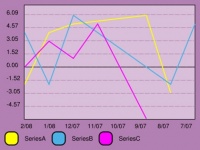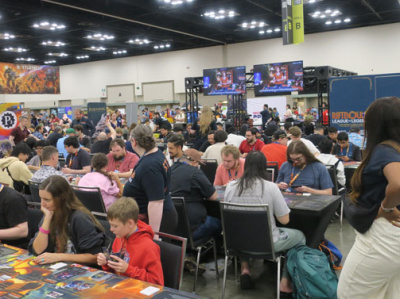 Talk the Talk, Walk the Walk is a weekly column by Kendall Swafford of Up Up Away! in Cincinnati, Ohio. This week, Kendall looks at the hidden truth of the monthly comic numbers.
Talk the Talk, Walk the Walk is a weekly column by Kendall Swafford of Up Up Away! in Cincinnati, Ohio. This week, Kendall looks at the hidden truth of the monthly comic numbers.It’s been a few weeks since I’ve been here. And for no other reason than I haven’t had a lot to talk about. I could complain about my Games Workshop account rep, but publicly complaining about my account reps has caused a ruckus in the past, so I’ll have to have his head on a pike in private, I suppose. I could talk about Tony Moore’s recent appearance in my store, and what a great turnout we had, and what a great guest Tony is to have in your store, and how much I adore his wife Kara. Or this seems like a good time to talk about the rapid-fire information flowing from C2E2 this weekend.
But then, it hits me. This past Tuesday saw the publication of John Mayo’s The Mayo Report over at Comic Book Resources. Eureka! I love John’s exhaustive look at the sales numbers provided by Diamond. John LOVES numbers, the crazy, mad fool. The month of February was a low-point for comic book sales, as the number one title for the month, Green Lantern, was the lowest-selling number one title since these numbers became public back in 2003, selling a craptacular 71,517 copies, more or less.
John does a terrific job of breaking down the numbers and pointing out trends that we should all be aware of. My problem with all of it is one that I’ve touched upon before. That all of the analysis in the world is only of limited use when it’s based on sell-IN data, rather than sell-THROUGH data. I know we’d all love to believe that they’re one and the same, but they’re not, sometimes not by a long shot. My own sell-through data shows I sold only 84.7% of the comic books that I received in February. It’s worth noting that we are looking at only new comics that arrived in February, including reorders, and have sold through as of Saturday, March 20th. This is three weeks after the arrival of the last of February’s new releases, with I think is sufficient time to analyze these numbers, as we’ve become incredibly front-loaded on new comic sales. That is to say, in recent years a greater percentage of our sales come from weeks 1-3, when historically we would look at a longer, 6-8 week sales period. Exceptions abound of course, feel free to shoot down my position at any time. Also, to keep things relatively consistent, I’m limiting my data to the top 300 titles. We’ll discuss shortly how my Top 300 compares with Diamond’s list.
So... My sell through on Diamond’s #1 title, Green Lantern #62 was 92.73%. A good, healthy sell-through, with some left over for future back-issue sales. Still, if this percentage is indicative of the national sell-through, that puts GL at 66,317 copies actually going into readers’ hands. And maybe that’s the elephant in the living room. I consider a leftover of 7+% on a top-selling title like Green Lantern to be healthy, and that represents a sell-through number that is over 5,000 copies less than the numbers we continue to put stock in. With my average leftover rate for February being 15.3%, that’s a huge number. Now, some of you may look at that and think, “15%!? That guy has no clue what he’s doing!” Maybe, maybe not. Is 15.3% higher than I’d like it to be? You bet it is. But I think all of us would like our leftovers to be less, wouldn’t we? Looking at just my Top 25, that leftover percentage drops to 11.27. Looking at my bottom 25? That’s a stunning 33% leftover rate! I wonder what the national average is? And that’s kinda my point. We don’t know what the national average leftover rate is. Or what sell-through numbers are on Green Lantern #62.
Decisions are made at the highest levels of this industry that are constantly based on flawed data. I’m certain everyone cringes at February numbers, and the last thing they want to think about is our bestselling title for the month actually sold 5,400 copies less than it did, or to put it in human terms, Green Lantern has potentially 5,400 less READERS than we want to believe. And maybe I’m wrong, but I don’t think I am. Maybe I was the only store on the planet that had any copies of GL #62 left over come March 1st, but I don’t think I was. For the sake of conversation, and the complete lack of any other tangible data, we’ll assume my numbers are... average.
Bottom line, we need an avenue for reporting sell-through numbers... a ComicScan, if you will. It can be an independent third party, such as ICv2, as I personally would prefer not to send the numbers back upstream to Diamond. But someone like ICv2, who has a history of sales analysis, would be a terrific resource. I think it’s time we start basing our decisions on real numbers, as harsh as they may sometimes be. Many of us spoke at great length at last month’s ComicsPRO meeting, and I’m hoping we can move this project forward this calendar year.
Looking at Diamond’s Top 300 is always an adventure for me personally, because it is almost always very different from what I’m seeing here in Cincinnati. Continuing our look at February, the Diamond charts show four of the top ten titles being published by Marvel, and six by DC, with Avengers charting highest for Marvel at the number four slot. At Up Up & Away!, Avengers placed FOURTEENTH, not fourth, and not a single Marvel title broke the Top 10 in February in my store. Fantastic Four #588 was my bestselling Marvel title in February, settling in at #11, and selling less than 62% as well as Brightest Day #20, my bestseller for the month. My bestseller, a DC comic, outsold my bestselling Marvel comic by 38%! Marvel placed only nine books in my Top 25 vs. sixteen in the Diamond charts.
What’s it all mean? Well, I am a DC kinda guy, I’ll admit, and I have been reminding people that DC’s good behavior ("Drawing The Line At $2.99") should be rewarded. But more than all that seems to be the general feeling among my customers that Marvel feels a little like a rudderless ship right now. I think they desperately need a mega-hit, and I hope Fear Itself is exactly that, but the ghost of $3.99 and the over-saturation of titles both hang over Marvel’s head. “What about 16 Flashpoint titles!?” you ask? Good question, as the Magic 8 Ball taught us, 'ask again later.' DC’s strategy makes sense, at least to me, but that leaves me something to talk about. Next time!
Until then, think about this. These numbers, as dry as they can be, mean something to all of us. Are my results the same as other stores in my market? Or in San Diego? Are their large regional pockets of support for one publisher or another? Are the Southern states largely Marvel zombies? Does New England vote DC? Detailed sell-through numbers reported to an independent party would give us real, useful data, data that informs our decisions. Knowledge IS power, my friends.
The opinions expressed in this column are solely those of the writer, and do not necessarily reflect the views of the editorial staff of ICv2.com.







